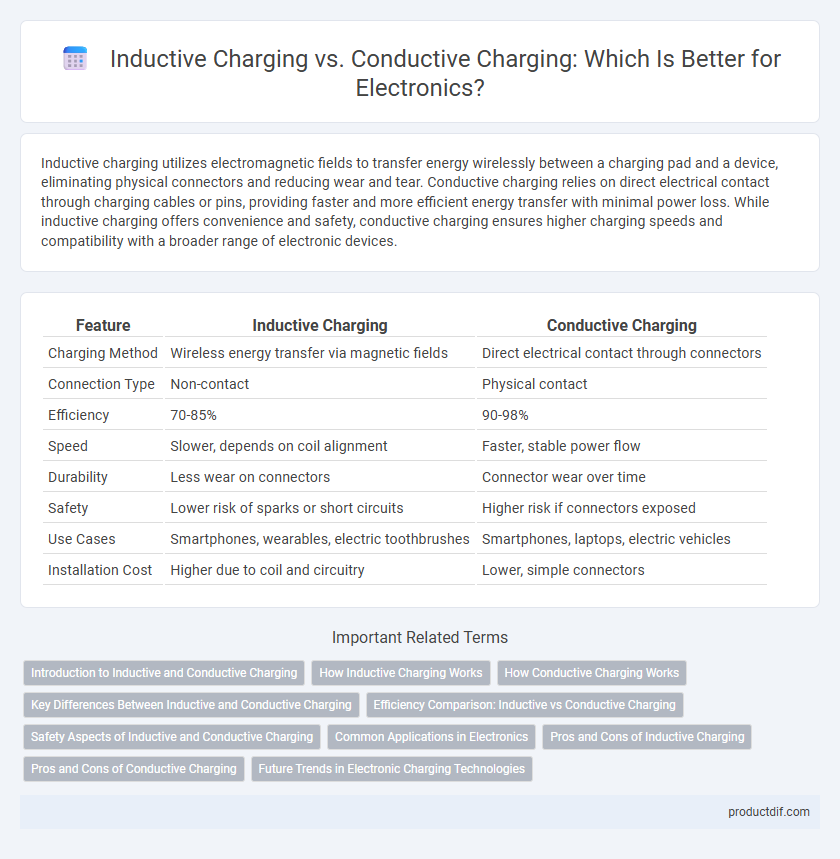Inductive charging utilizes electromagnetic fields to transfer energy wirelessly between a charging pad and a device, eliminating physical connectors and reducing wear and tear. Conductive charging relies on direct electrical contact through charging cables or pins, providing faster and more efficient energy transfer with minimal power loss. While inductive charging offers convenience and safety, conductive charging ensures higher charging speeds and compatibility with a broader range of electronic devices.
Table of Comparison
| Feature | Inductive Charging | Conductive Charging |
|---|---|---|
| Charging Method | Wireless energy transfer via magnetic fields | Direct electrical contact through connectors |
| Connection Type | Non-contact | Physical contact |
| Efficiency | 70-85% | 90-98% |
| Speed | Slower, depends on coil alignment | Faster, stable power flow |
| Durability | Less wear on connectors | Connector wear over time |
| Safety | Lower risk of sparks or short circuits | Higher risk if connectors exposed |
| Use Cases | Smartphones, wearables, electric toothbrushes | Smartphones, laptops, electric vehicles |
| Installation Cost | Higher due to coil and circuitry | Lower, simple connectors |
Introduction to Inductive and Conductive Charging
Inductive charging uses electromagnetic fields to transfer energy wirelessly between a charging pad and a device, eliminating the need for physical connectors. Conductive charging relies on direct electrical contact through connectors or pins to deliver power efficiently. Both methods have distinct applications in electronics, with inductive charging offering convenience and conductive charging providing faster, more reliable energy transfer.
How Inductive Charging Works
Inductive charging transfers energy wirelessly through electromagnetic fields created by a charging pad and a compatible receiver coil in the device. When an alternating current passes through the transmitter coil, it generates a magnetic field that induces a current in the receiver coil, converting magnetic energy back into electrical energy to charge the battery. This method eliminates physical connectors, enhancing convenience and reducing wear on charging ports.
How Conductive Charging Works
Conductive charging transfers electrical energy through direct physical contact between the charging device and the receiver, typically using metal contacts or connectors. This method ensures efficient power delivery with minimal energy loss, making it faster and more reliable for devices like smartphones, electric vehicles, and wearables. Conductive charging systems require precise alignment and robust connectors to maintain consistent conductivity and safety during the charging process.
Key Differences Between Inductive and Conductive Charging
Inductive charging uses electromagnetic fields to transfer energy wirelessly between a charging pad and a device, while conductive charging requires physical contact through connectors or cables to deliver power. Inductive systems offer convenience and reduced wear on connectors, but typically exhibit lower efficiency and slower charging speeds compared to conductive methods. Conductive charging provides faster energy transfer and higher efficiency, making it optimal for devices requiring quick recharge cycles and consistent power delivery.
Efficiency Comparison: Inductive vs Conductive Charging
Conductive charging typically offers higher energy transfer efficiency, often exceeding 85%, due to direct electrical contact minimizing power loss. Inductive charging efficiency ranges between 70% and 80%, influenced by coil alignment, distance, and environmental factors causing electromagnetic energy dissipation. When prioritizing fast and effective energy transfer, conductive charging remains the preferred method for maximizing power efficiency in electronic devices.
Safety Aspects of Inductive and Conductive Charging
Inductive charging offers enhanced safety by eliminating direct electrical contacts, reducing the risk of electric shock and exposure to water or dust during the charging process. Conductive charging, while efficient, requires physical connectors that can wear out or cause sparking, posing potential hazards especially in moist or dirty environments. Advanced safety features in inductive systems, such as foreign object detection and automatic shutoff, further mitigate risks inherent to traditional conductive methods.
Common Applications in Electronics
Inductive charging is widely used in wireless earbuds, smartphones, and electric toothbrushes due to its convenience and portability, enabling contactless power transfer through electromagnetic fields. Conductive charging remains prevalent in electric vehicles (EVs), laptops, and power tools, offering higher efficiency and faster charging times via direct electrical contact. Both methods power diverse electronic devices, with inductive preferred for compact, user-friendly gadgets and conductive favored for high-power, performance-critical applications.
Pros and Cons of Inductive Charging
Inductive charging offers the advantage of convenience and reduced wear due to its wireless nature, eliminating the need for physical connectors and cables. However, it generally has lower energy efficiency and slower charging speeds compared to conductive charging, leading to longer charge times and potential energy loss. Safety is enhanced with inductive charging as it minimizes electric shock risk, but alignment sensitivity and higher initial costs can limit its practicality for some devices.
Pros and Cons of Conductive Charging
Conductive charging offers efficient energy transfer with minimal heat generation, ensuring fast and consistent charging for electronic devices. Its reliance on physical contact points makes it reliable but vulnerable to wear, corrosion, and dirt, which can reduce performance over time. While it excels in energy efficiency, the need for precise alignment and potential mechanical degradation limits flexibility compared to inductive charging methods.
Future Trends in Electronic Charging Technologies
Inductive charging is advancing rapidly with innovations in resonance technology, enabling faster and more efficient wireless power transfer for electric vehicles and wearable devices. Conductive charging continues to improve through smart connectors and higher power densities, supporting faster charging times for smartphones and electric vehicles with minimal energy loss. Emerging trends include hybrid systems combining inductive and conductive methods to optimize convenience, efficiency, and user experience in next-generation electronic charging solutions.
Inductive Charging vs Conductive Charging Infographic

 productdif.com
productdif.com